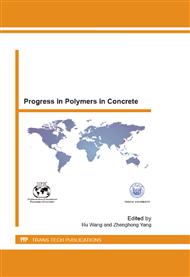p.298
p.303
p.311
p.316
p.322
p.329
p.335
p.341
p.347
Effect of Ca2+ Ions on the Film Formation of an Anionic Styrene/n-Butylacrylate Latexpolymer in Cement Pore Solution
Abstract:
Several methods were employed to study the time dependent film formation of a self synthesized anionic latex dispersion in water and cement pore solution. First, a model carboxylated styrene/n-butyl acrylate latex dispersion possessing a minimum film forming temperature (MFFT) of 18 °C and a glass transition temperature (Tg) of 30 °C was synthesized via emulsion polymerization. Next, its film forming behaviour was studied at 40 °C, using an ESEM instrument. The analysis revealed that upon removal of water, film formation occurs as a result of particle packing, particle deformation and finally particle coalescence. Film formation is significantly hindered in synthetic cement pore solution. This effect can be ascribed to adsorption of Ca2+ ions onto the surface of the anionic latex particles and to interfacial secondary phases. This layer of adsorbed Ca2+ ions hinders interdiffusion of the macromolecules and subsequent film formation of the latex polymer.
Info:
Periodical:
Pages:
322-328
Citation:
Online since:
April 2013
Authors:
Keywords:
Price:
Сopyright:
© 2013 Trans Tech Publications Ltd. All Rights Reserved
Share:
Citation:


